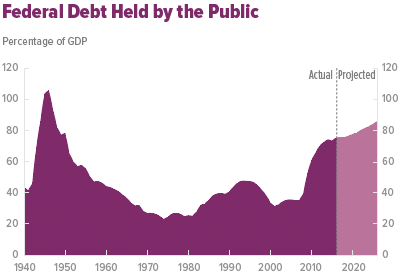U.S. National Debt
A U.S. National Debt is a national debt for a U.S. government.
- Context:
- It can be associated to a U.S. Government Debt w.r.t. GDP or U.S. per Capita Government Debt.
- It can range from being a Total U.S. Government Debt to being a Net U.S. Government Debt.
- It can range from being a Internally-Held U.S. Government Debt to being a Externally-Held U.S. Government Debt.
- Example(s):
- a U.S. National Debt of 1940.
- a U.S. National Debt of 2017-02-12, of ~$20,628,595,900,000 (~$63,000 per capita).
- …
- Counter-Example(s):
- Japanese National Debt, Canadian National Debt, German National Debt, ...
- U.S. Personal Debt, such as ~$18,848,539,000,000 on 2018-02-12 (or ~$57,602 per capita).
- …
- See: U.S. Federal Annual Budget Deficit, United States Debt Ceiling, Federal Government of The United States, United States Treasury, Government Budget Balance.
References
2018
- (Wikipedia, 2018) ⇒ https://en.wikipedia.org/wiki/National_debt_of_the_United_States Retrieved:2018-2-12.
- The national debt of the United States is the debt carried by the federal government of the United States. The public debt is measured as the value of the currently outstanding Treasury securities that have been issued by the Treasury and other federal government agencies. The terms national deficit and national surplus usually refer to the federal government budget balance from year to year, not the cumulative amount of debt. A deficit year increases the debt as more money is spent than is received by the government; a surplus year decreases the debt as more money is received than spent.
There are two components of gross national debt: * Debt held by the public, such as Treasury securities held by investors outside the federal government, including those held by individuals, corporations, the Federal Reserve System, and foreign, state and local governments. * Debt held by government accounts or intragovernmental debt, such as non-marketable Treasury securities held in accounts of programs administered by the federal government, such as the Social Security Trust Fund. Debt held by government accounts represents the cumulative surpluses, including interest earnings, of various government programs that have been invested in Treasury securities. In general, government debt increases as a result of government spending, trade deficits, and unpaid credit, and decreases from tax or other receipts, both of which fluctuate during the course of a fiscal year. In practice, Treasury securities are not issued or redeemed on a day-by-day basis, and may also be issued or redeemed as part of the federal government's macroeconomic monetary management operations. The aggregate, gross amount that Treasury can borrow is limited by the United States debt ceiling. [1] Historically, the US public debt as a share of gross domestic product (GDP) has increased during wars and recessions, and subsequently declined. The ratio of debt to GDP may decrease as a result of a government surplus or due to growth of GDP and inflation. For example, debt held by the public as a share of GDP peaked just after World War II (113% of GDP in 1945), but then fell over the following 35 years. In recent decades, aging demographics and rising healthcare costs have led to concern about the long-term sustainability of the federal government's fiscal policies. [2] On November 7, 2016, debt held by the public was $14.3 trillion or about 76% of the previous 12 months of GDP. [3] Intragovernmental holdings stood at $5.4 trillion, giving a combined total gross national debt of $19.8 trillion or about 106% of the previous 12 months of GDP; $6.2 trillion or approximately 45% of the debt held by the public was owned by foreign investors, the largest of which were Japan and China at about $1.09 trillion for Japan and $1.06 trillion for China as of December 2016.
- The national debt of the United States is the debt carried by the federal government of the United States. The public debt is measured as the value of the currently outstanding Treasury securities that have been issued by the Treasury and other federal government agencies. The terms national deficit and national surplus usually refer to the federal government budget balance from year to year, not the cumulative amount of debt. A deficit year increases the debt as more money is spent than is received by the government; a surplus year decreases the debt as more money is received than spent.
- ↑ About 0.8% of debt ($79 billion) is not covered by the ceiling, per The Debt Limit: History and Recent Increases, p. 4. (Note: This includes pre-1917 debt), fpc.state.gov; accessed August 24, 2016.
- ↑ Congressional Budget Office – The 2014 Long-Term Budget Outlook in 26 Slides
- ↑ BEA-Gross Domestic Product
2016
- https://www.cbo.gov/publication/51129
- QUOTE: CBO estimates that the federal budget deficit in 2016 will be $544 billion, raising debt held by the public to 76 percent of GDP. Solid short-term growth in the economy is projected to be followed by slower growth in subsequent years.

- QUOTE: CBO estimates that the federal budget deficit in 2016 will be $544 billion, raising debt held by the public to 76 percent of GDP. Solid short-term growth in the economy is projected to be followed by slower growth in subsequent years.